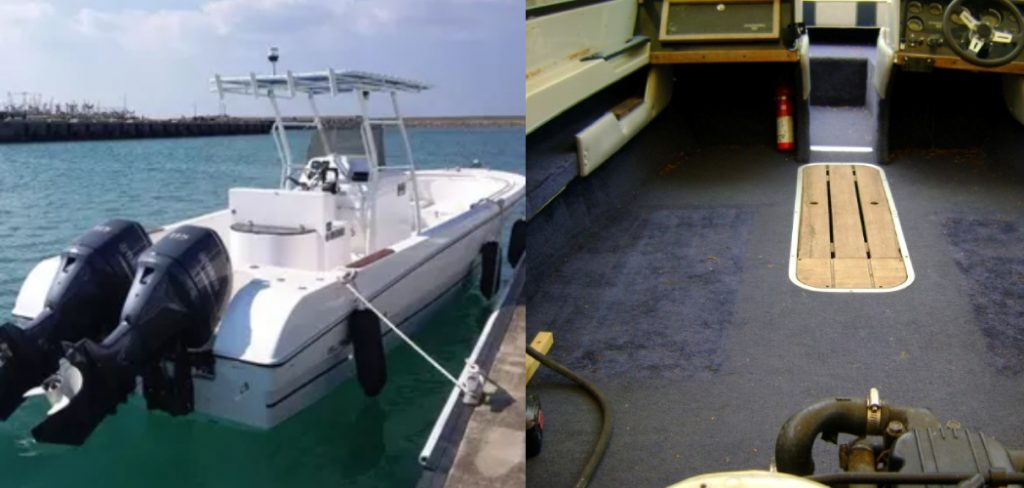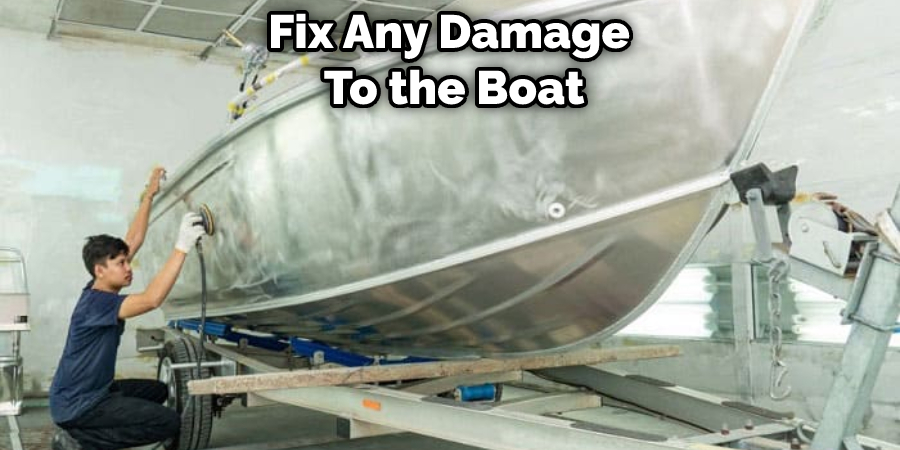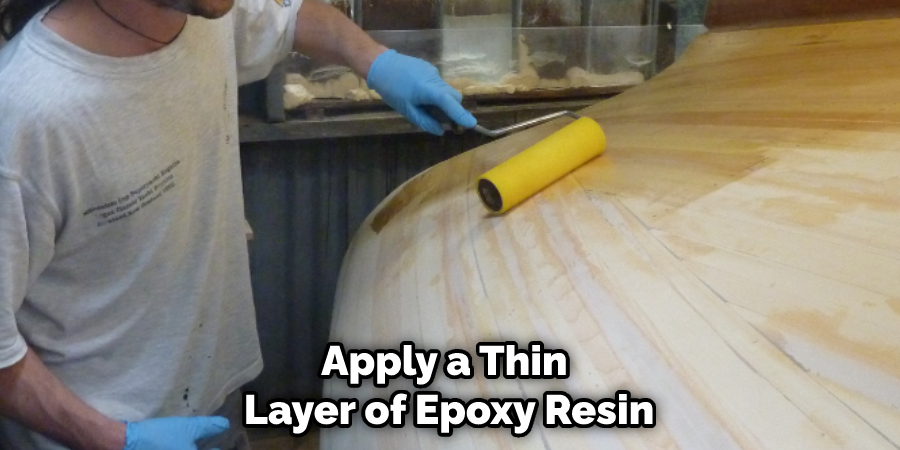Do you have a fiberglass boat that needs some repairs on the floor? Maybe there is a hole or a crack in it. Don’t worry; there are ways to fix this, and it isn’t as hard as you might think. In this blog post, we will walk you through how to fix fiberglass boat floor using epoxy resin.

We will also give you tips on how to repair it last longer. So if your boat needs some TLC, keep reading!
Summary: As the owner of a fiberglass boat, you know that your floor is one of the most important parts of the boat. Unfortunately, fiberglass boats are notoriously difficult to fix if something goes wrong. In this article, we will teach you how to fix a fiberglass boat floor in case of a problem.
What Is a Fiberglass Boat Floor?
Fiberglass boat floors are a good choice because they are strong and won’t get slippery when they get wet. They also won’t rot or get moldy.
Fiberglass is not only easier to clean than wood, but it is also more resistant to fading and discoloration over time. Best of all, fiberglass boat floors can be customized to match the look of your boat’s interior.
Whether you’re looking for a classic teak deck or something more modern, fiberglass provides a versatile and durable material that will give your boat a stylish new look.
Why Should You Fix Fiberglass Boat Floor?
The key to a long-lasting vessel is proper maintenance, and the floor is often one of the most neglected areas. Over time, the constant exposure to the sun, salt water, and sand can take a toll on even the toughest materials.
As a result, it’s important to fix any damage to the floor as soon as possible. Fiberglass is one of the most popular materials for boat floors and a good reason. It’s strong and durable, and it resists UV damage and fading. Additionally, fiberglass is easy to clean and maintain. However, even fiberglass can be damaged by wear and tear. Cracks, chips, and holes will not only affect the appearance of your boat but can also lead to serious leaks.

That’s why it’s so important to fix any damage to your fiberglass floor as soon as you notice it. Then, with a little time and effort, you can keep your boat looking and performing like new for years to come.
How to Fix Fiberglass Boat Floor Step by Step Guide
1.Assess the Damage:
Before starting any repair work, thoroughly inspect the fiberglass boat floor to determine the extent of the damage. Identify any cracks, holes, or delaminations, and check for signs of water intrusion or rot in the underlying structure. This assessment will help you determine the necessary steps and materials for the repair.
2. Gather materials and tools:
To repair a fiberglass boat floor, you will need the following materials and tools:
- Fiberglass cloth or mat
- Epoxy resin and hardener
- Acetone
- Sandpaper (80 and 120 grit)
- Angle grinder or rotary tool with a cutting wheel
- Mixing containers and stir sticks
- Protective gloves, goggles, and mask
- Utility knife or scissors
- Paintbrush or roller
- Marine plywood (if replacing the core)
- C-clamps or heavy objects (if clamping is necessary)
Remove damaged fiberglass:
3.Using the angle grinder or rotary tool, carefully cut away the damaged fiberglass surrounding the affected area. Create a beveled edge that tapers down to the healthy fiberglass, ensuring a smooth transition between old and new material. This will provide a strong bond when applying new fiberglass layers.
4.Clean and prep the area:
Once the damaged fiberglass has been removed, thoroughly clean the area with acetone to remove any dust, dirt, or contaminants. Sand the exposed edges with 80-grit sandpaper to roughen the surface, promoting better adhesion for the new fiberglass.
5.Replace the core (if necessary):
If water damage or rot has compromised the boat floor’s core, you will need to replace it. Cut a piece of marine plywood to the size and shape of the damaged area. Coat the edges and both sides of the plywood with epoxy resin, ensuring full coverage. Place the plywood in the cutout, and weigh it down or clamp it to create a tight bond with the surrounding floor structure. Allow the epoxy to cure according to the manufacturer’s instructions.
6.Cut fiberglass layers:
Measure and cut the necessary layers of fiberglass cloth or mat to cover the repair area. Ensure each layer is slightly larger than the previous one, creating a staggered, overlapping effect. This will help build up the thickness of the repair and provide added strength.
7.Mix epoxy resin:
Following the manufacturer’s instructions, mix the epoxy resin and hardener in a clean container. Be sure to mix the correct proportions to ensure proper curing. Work in a well-ventilated area and wear protective gear to avoid inhaling fumes or coming into direct contact with the epoxy.
8.Apply fiberglass layers:
Starting with the smallest piece of fiberglass, coat one side with epoxy resin using a paintbrush or roller. Press the fiberglass onto the repair area, ensuring full contact and no air bubbles. Repeat this process for each subsequent layer, making sure to stagger the edges and fully saturate the fiberglass with epoxy. Use a paintbrush or roller to smooth out any wrinkles or bubbles, working from the center outwards.
9.Allow epoxy to cure:
Once all layers of fiberglass have been applied, allow the epoxy to cure according to the manufacturer’s instructions. This may take several hours or even days, depending on the epoxy’s formulation and environmental conditions.
10.Sand and smooth the repair:
After the epoxy has fully cured, sand the repair area with 80-grit sandpaper to remove any rough spots or high points. Gradually work up to 120-grit sandpaper for a smoother finish. Make sure the repaired area blends seamlessly with the surrounding floor and has a uniform texture.
11.Apply a protective coating:
To protect the repair and ensure longevity, apply a marine-grade paint or gelcoat to the repaired area. Follow the manufacturer’s instructions for proper application and curing times. This final layer will not only provide a protective barrier against water and UV damage but also give the repaired area a uniform appearance, matching the rest of the boat floor.
12.Inspect for quality:
Once the protective coating has fully cured, inspect the repaired area to ensure it is level, smooth, and free of any imperfections. Check the bond between the new fiberglass and the existing floor to confirm there are no gaps or weak points.
13.Reinstall hardware and equipment:
If you had to remove any hardware or equipment, such as seats, cleats, or storage compartments, to access the damaged area, reinstall them securely. Ensure all fasteners are tightened properly and any seals are intact to prevent water intrusion.
14.Perform routine maintenance:
To prolong the life of your fiberglass boat floor and prevent future damage, perform routine maintenance tasks, such as cleaning, inspecting, and sealing any potential leaks. Regularly check for signs of wear or damage and address any issues promptly to avoid more extensive repairs.
15.Practice preventative measures:
To minimize the risk of damage to your boat floor, avoid dragging heavy or sharp objects across the surface, and promptly address any water leaks or spills. Additionally, use non-abrasive cleaning products and tools to prevent scratches or damage to the protective coating. Taking these preventative measures will help ensure the longevity of your fiberglass boat floor and maintain its appearance and functionality.
By following these steps, you can successfully repair a damaged fiberglass boat floor, restoring its structural integrity and appearance. Although the process can be time-consuming and requires attention to detail, a well-executed repair will provide a durable and lasting solution, allowing you to enjoy your boat for years to come.
You Can Check It Out to Fix Rotted Boat Floor
How Do You Fix a Stress Crack in A Fiberglass Boat?
Stress cracks in fiberglass boats can be a common problem, but they can also be relatively easy to fix with the right tools and techniques. The first step is to clean the area around the crack with sandpaper or a wire brush. This will help rough up the surface and provide a better grip for the repair material. By taking the time to do this step, you can ensure that your repair will be successful.
Next, apply a thin layer of epoxy resin to the crack using a putty knife or small brush. Once the epoxy has had a chance to set, apply a layer of fiberglass cloth over the top. Once again, allow the epoxy to set before trimming away any excess material.

With some patience and attention to detail, it is possible to repair stress cracks in fiberglass boats to virtually indistinguishable from the rest of the hull.
Can You Epoxy Fiberglass Boat?
Epoxy is a two-part adhesive that, when mixed, creates a very strong bond. It is often used in boatbuilding and repairs because it can be used on wet or dry surfaces, and it will not deteriorate over time like other adhesives. Fiberglass is a type of cloth that is impregnated with resin, which makes it extremely strong and durable.
When combined, epoxy and fiberglass create an incredibly strong bond that can be used to repair boats and other structures. However, it is important to note that experienced professionals should only attempt this type of repair. Improperly mixed epoxy or incorrect application can lead to serious injury or damage to property.
For this reason, always consult with a professional before attempting any epoxy repair. Keep reading for more information about how to fix fiberglass boat floor.
What Is the Difference Between Fiberglass Resin and Epoxy?
When working with fiberglass, there are two main types of resin: fiberglass resin and epoxy. Both bind the fibers together and provide a strong, durable surface. However, there are some key differences between the two.
Fiberglass resin is typically cheaper and easier to work with, but it is not as strong as epoxy. On the other hand, Epoxy is more expensive and difficult to work with, but it is much stronger. As a result, it is often used in applications where strength is critical, such as in boat hulls and airplane wings.
When deciding which type of resin to use, it is important to consider the desired properties of the finished product.
What Kind of Epoxy Should I Use on My Boat?
There are many different types of epoxy, and each has its advantages and disadvantages. For example, some epoxies are better suited for use in salt water, while others are more resistant to UV light. As a result, it is important to choose the right epoxy for your particular boat.
One type of epoxy that is often used on boats is a polyester resin. This type of resin is relatively inexpensive and easy to work with, and it can be tinted to match the color of your boat. However, polyester resin is not as durable as some other types of epoxy, and it may not provide the same level of protection from the elements.
If you are looking for a more durable option, you might consider using vinyl ester resin. This type of resin is more expensive than polyester resin, but it is also more resistant to UV light and chemical damage. Ultimately, the best epoxy for your boat will depend on your specific needs and preferences.
Frequently Asked Question
Can Jb Weld Be Used on Fiberglass?
Yes, Jb Weld can be used on fiberglass. For example, you can use Jb Weld to patch up the fiberglass boat floor. First, sand down the area that needs to be patched. Then, clean the area with acetone. Next, apply the Jb Weld and let it dry.
Can You Fibreglass Over Fibreglass?
Yes, you can fibreglass over fibreglass. Just make sure the surface is clean and dry before you start. You may also need to use a primer to help the new layer stick.
Are Stress Cracks Normal on Boats?
It is normal for boats to experience stress cracks, and they can often be repaired with a fiberglass patch kit. If the cracks are small and do not affect the boat’s structural integrity, they can often be fixed with a resin-based adhesive. However, if the cracks are larger or if the boat’s structural integrity is compromised, it is best to consult a professional.
What Is Gelcoat Putty?
Gelcoat putty is a two-part epoxy system used to repair fiberglass boat floors. First, the putty is applied over the damaged area and then sanded down until it is flush with the existing surface. Once the putty has cured, it can be painted or sealed with a sealant to protect it from the elements.
Conclusion
Boat floor repair is necessary to keep your boat in good condition. By following the steps in this guide, you can fix your fiberglass boat floor and get it back into the water. Thanks for reading our post about how to fix fiberglass boat floor. Have any questions about the process? Leave us a comment below.
